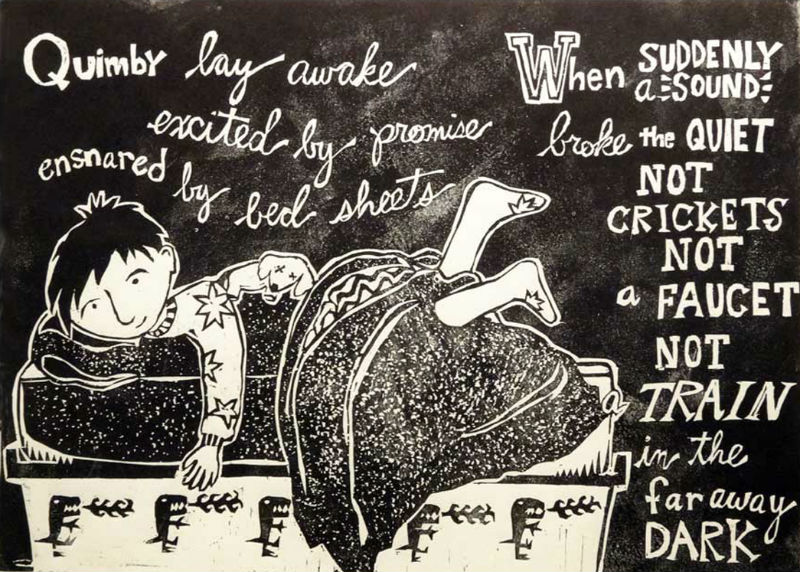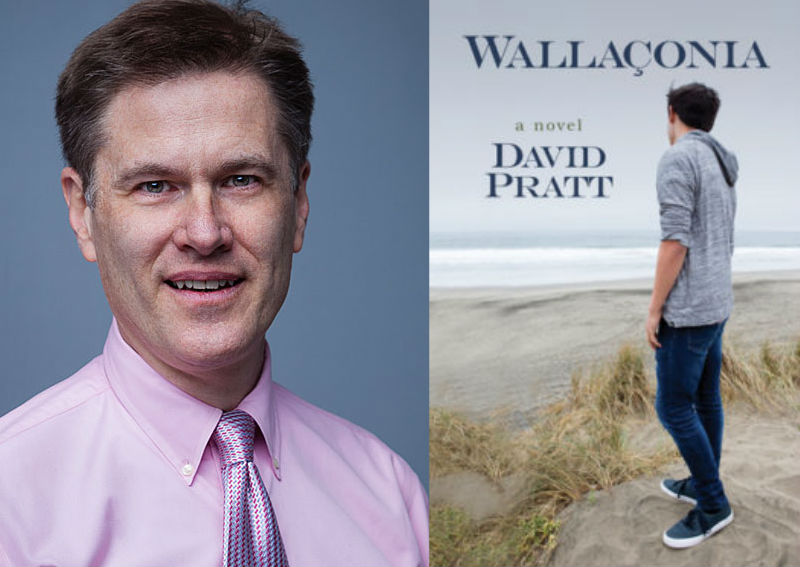Carving Out a Niche: Marian Short's "Cakeasaurus: Scenes From a Picture Book"

Cakeasaurus, the gleefully cake-thieving, sweet-sneaking monster brainchild of Ann Arbor printmaker/storyteller Marian Short, will be lurking on the walls and in the halls of the Taubman Health Center's North Lobby from now until June 11, 2017. Cakeasaurus: Scenes From a Picture Book is curated by Gifts of Art, a program designed to bring art and music to patients, visitors and staff in the University of Michigan Health System.
Amusingly paired with this series of Cakeasaurus prints are the sweet yet dangerous-looking glass confections of Janet Kelman. A combination of pate de verre, slumped and sheet glass, the sugary looking cupcakes and gateaux look delicious, but engender feelings of both attraction and dismay at the thought of biting into one of these glossy but inedible desserts. Cakeasaurus beware!
The (mostly) wood block prints in Cakeasaurus: Scenes From a Picture Book describe the exploits of the cake-stealing monster through its 8-year development from inception into what Short hopes will soon become a children’s book. They track the artist’s process as she refines, rethinks, and develops the story visually and narratively. Short is generous and humorous in her explanations of her creative process and thoughtfully provides several large explanatory prints, visually satisfying in their own right, to accompany the smaller artworks.
Purple Rose’s Vino Veritas finds humor and pain in the middle class

The Purple Rose Theatre has made its mark as an outstanding professional theater company with smart, contemporary comedies with a sting.
So it’s appropriate that the Chelsea theater founded by Jeff Daniels would mark its 100th presentation with a new production of Detroit playwright David MacGregor’s Vino Veritas, which had its world premiere at the Purple Rose in 2008. It is a fine example of the plays that the company has premiered over the years. It’s contemporary, witty, fast-paced but also biting, brutally honest, and perceptive about the worries and frustrations of middle-class Americans.
Vino Veritas is set in “an upper middle class living room” on Halloween night. As the play opens a couple are waiting for their neighbors to come for a drink before they all head off for their annual appearance at a costume party.
The couple has recently returned from a trip to Peru. This was a rare adventure for the two studio photographers who had once been daring photojournalists. It was, it seems, an attempt to re-spark a troubled relationship. While there, the wife is given a bottle of wine made from the skin of blue dart tree frogs. The wine is alleged to be a truth serum.
The wife wants to share the wine with their neighbors; the husband is horrified by the idea. The madness ensues when the wine flows.
A World of Music: Galeet Dardashti & Divahn at The Ark
"Well, it was only natural that a Jewish Middle Eastern band should form in Austin, right?" joked singer Galeet Dardashti when asked how she formed the band Divahn.
Though Dardashti and Divahn don't have any Texas twang in their music, the songs they create aren't hemmed in by geographical or cultural boundaries. The group blends Persian, Jewish, Arabic, and Indian music, with touches of European classical and American/Latin jazz, into a worldly blend that seeks to highlight our universal commonalities, regardless of the land under your feet.
It's music made to spark a bright light during a time filled with murky shadows.
"We chose to record our new song, 'Banu Choshesh Legaresh (We’ve Come to Chase Away the Darkness),' for our upcoming album because the lyrics really spoke to us. It’s a Hanukah song and we decided to record it right after the November election. Hanukah is all about overcoming the darkness and we were all very down and in need of some of that Hanukah light. The Hebrew lyrics are:
We’ve come to chase away the darkness
We bear light and fire
Each glimmer is small
But together, our blaze is fierce
Flee, darkness
Go away, night
Flee, before the light
The lyrics gave us hope, reminding us that we are more powerful when we resist/persist together. Our fans really loved the song and so we -- with the help of a friend -- made our first music video." (See above.)
Divahn plays The Ark on Monday, April 3, and we talked to Dardashti about her family's rich musical history, the band's hearty sonic soup, and being an all-female band performing an all-male repertoire when it tackles traditional tunes.
Complicite’s "The Encounter" is a hallucinatory audio playground

Thursday’s opening night performance of Complicite’s The Encounter, presented by UMS (and running through Saturday night), got me thinking about how, when you’re a parent of young kids, you notice on a daily basis how their powers of imagination, and capacity for wonder, utterly dwarf your own. Now, this isn’t too surprising when you consider how often kids are encouraged to conjure up stories and images, while the adults around them are stuck in “adulting” mode: worrying about work, home upkeep, money, relationships, emails, appointments, and various other responsibilities.
So how do you lure a capacity crowd of over-stressed adults down the rabbit hole of imagination and deep into the Amazonian rainforest? By finding new, innovative ways to open this often-jammed door in our brains.
With The Encounter, Complicite -- one of Britain’s (and the world’s) most inventive theater companies -- achieves new levels of theatrical immersion by delivering the show’s time-hopping, atmospheric narrative to the audience through headphones; employing a visceral, binaural soundscape (designed by Gareth Fry, with Pete Malkin) that does a real number on your perception; and through employing lighting (Paul Anderson) and projections (Will Duke) that make a deceptively spare set (Michael Levine) -- with a textured foam backdrop, suggesting an enormous recording studio -- into a hallucinatory playground.
U-M’s "Insurrection" uses drama, comedy in a swirling, challenging trip through time

Time travel is a hot topic with three new television series featuring characters who travel back to historic events and learn some lessons about history and themselves.
Robert O’Hara’s 1995 play Insurrection: Holding History takes a fantastical and theatrical approach to time travel to offer some rich insights into African-American history and the continuing friction between black and white Americans.
The production by the University of Michigan’s Department of Theatre and Drama at the Arthur Miller Theatre takes a fine measure of O’Hara’s swirling combination of broad satirical comedy, cultural touchstones, and searing drama as Insurrection moves back and forth from the present to the doomed and bloody 1831 slave uprising of Nat Turner.
Theatre Nova's "Clutter" explores the traps of false memories

Much like a plaster casting mold, most modern American plays squeeze themselves into ready-made stylistic and thematic models that have a good track record. The styles can often be pinpointed back to one or two particularly significant behemoths that are scattered throughout the history of the American theater. One such theatrical prototype is the Memory Play. It was initially popularized by playwright Tennessee Williams in the preface for his 1945 drama The Glass Menagerie. As Williams described it, “When a play employs unconventional techniques, it is not, or certainly shouldn’t be, trying to escape its responsibility of dealing with reality, or interpreting experience, but is actually or should be attempting to find a closer approach, a more penetrating and vivid expression of things as they are.” The playwrights Pinter (Betrayal), Friel (Dancing at Lughnasa), and Leonard Jr. (The Diviners) are all known for their Memory Plays. Each examined different subjects, but all used the power of characters retelling their memories and dreams to exaggerate details in order to increase the emotional impact of those stories. Clutter, the new show at Theatre Nova written by Brian Cox, is a world premiere Memory Play about the traps of false memories that we set for ourselves by taking part in nostalgic rumination.
Gift of Character: David Pratt launches "Wallaçonia" at Common Language

We all feel isolated during adolescence. But Jim Wallace, the main character in Ann Arbor-based author David Pratt’s new book, Wallaçonia, does something about it.
Feeling alienated from his own world, Jim imagines his parents’ yard and woods as his private country -- the titular Wallaçonia. But as we all must do, Jim grows up and realizes he has to leave behind not only his secret place but certain assumptions he made about himself.
Bookseller Pat Baxter asks Jim to work at his store with him over Christmas break. Jim at first feels conflicted about working for the openly gay Baxter. But when Jim’s father makes fun of Baxter, Jim takes a stand by working for him. He feels he should stand by this man and be an ally to Baxter. Through the course of the book, Jim realizes that is more than an ally -- he is gay himself.
“The book is more about the 'how' than the 'what,'” Pratt said. “Jim has some of the same insecurities as Pat and it was important to me to have a setting where they could talk and get to know each other.”
Choro-scuro: Danilo Brito brings Brazil's soul to Kerrytown Concert House
"Heitor Villa-Lobos said that choro represents the soul of Brazilian people," said Danilo Brito, a mandolinist from São Paulo who plays this form of music that Brazil's legendary composer so beloved.
The 32-year-old Brito has been playing choro -- a high-spirited, waltz- and polka-influenced music that dominated Brazilian popular music from the late 19th century and well into the 20th -- since he was a child. At age 10, he would go to music shops that hosted choro jams and would sit in with much older players, and at 19 he won the Prêmio Visa de Música Popular Brasileira, a prestigious competition that was held in São Paulo between 1998 and 2006.
As one of the leading exponents of choro, Brito is dedicated to exploring the genre's history and expanding on its compositional template, which typically includes three sections, all in different keys. "Choro continues to be played, composed, and is a living rich genre," he said.
Brito and his band -- Carlos Moura (7-string guitar), Guilherme Girardi (6-string guitar), and Lucas Arantes (cavaquinho, a small 4-string guitar) -- will demonstrate choro's lifeforce with a show at Kerrytown Concert House on Saturday, April 1. We talked with the mandolinist about his musical background and what makes choro the heart of all Brazilian popular music.
Lullabies & "Lullaboy": Broadway star Jessica Grové sings to benefit Encore Theater

At this point in her career, actress/singer Jessica Grové -- whose Broadway credits include A Little Night Music (with Bernadette Peters and Elaine Stritch), Sunday in the Park with George, Thoroughly Modern Millie, and Les Miserables -- is ready to venture into new, more personal territory: a cabaret show titled I Have Found: A Journey Through Song with Jessica Grove, which she’ll premiere this weekend at Dexter’s Encore Theater. (Friday’s performance is concert-only, while Saturday’s is Encore’s gala fundraiser.)
“I’ve done concerts before -- like, an hour-long concert of songs -- but cabaret is a whole different art form,” said Grové. “You have to tie them together in a meaningful way, and have a climax, and have a realization and a summation. Those are writer things, and I’ve never considered myself a writer, but I’ve really enjoyed the process.”
Author Events: April 2017

What does having an amazing university, a plethora of fantastic local independent bookstores, and a pretty slam-bang public library system (if we do say so ourselves) bring to a town?
Authors. Lots and lots of authors.
Authors big and small, renowned writers and first-time novelists, crafters of poetry, prose, fiction, and nonfiction often grace the Ann Arbor region with lectures, discussions, readings, and book signings. The fact that so many awesome authors want to come speak here and meet their southeast Michigan readers is a testament to how voraciously we devour books here in Washtenaw County.
In fact, so many authors pass through the area that sometimes it can be hard to keep track of who is speaking and when and where. To help guide you, Pulp curated a highlights list of April 2017 author events.


































